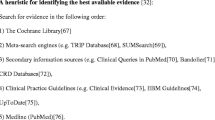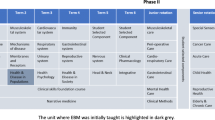Abstract
Background
Evidence-based medicine (EBM) is widely taught in residency, but evidence for effectiveness of EBM teaching on changing residents’ behavior is limited.
Objective
To investigate the impact of an EBM curriculum on residents’ use of evidence-based resources in a simulated clinical experience.
Design/Participants
Fifty medicine residents randomized to an EBM teaching or control group.
Measurements
A validated test of EBM knowledge (Fresno test) was administered before and after intervention. Post intervention, residents twice completed a Web-based, multiple-choice instrument (15 items) comprised of clinical vignettes, first without then with access to electronic resources. Use of electronic resources was tracked using ProxyPlus software. Within group pre–post differences and between group post-test differences were examined.
Results
There was more improvement in EBM knowledge (100-point scale) for the intervention group compared to the control group (mean score increase 22 vs. 12, p = 0.012). In the simulated clinical experience, the most commonly accessed resources were Ovid (71% of residents accessed) and InfoPOEMs (62%) for the EBM group and UptoDate (67%) and MDConsult (58%) for the control group. Residents in the EBM group were more likely to use evidence-based resources than the control group. Performance on clinical vignettes was similar between the groups both at baseline (p = 0.19) and with access to information resources (p = 0.89).
Conclusions
EBM teaching improved EBM knowledge and increased use of evidence-based resources by residents, but did not improve performance on Web-based clinical vignettes. Future studies will need to examine impact of EBM teaching on clinical outcomes.
Similar content being viewed by others
References
Accreditation Council for Graduate Medical Education. General Competencies. (http://www.acgme.org/outcome/comp/compFull.asp). Accessed 8/13/08.
Sidorov J. How are internal medicine residency journal clubs organized, and what makes them successful. Arch Intern Med. 1995;155:1193–7.
Green ML. Evidence-based medicine training in internal medicine residency programs: a national survey. J Gen Intern Med. 2000;15:129–33.
Coomarasamy A, Khan KS. What is the evidence that postgraduate teaching in evidence based medicine changes anything? A systematic review. BMJ. 2004;329:1017–21.
Hatala R, Guyatt G. Evaluating the teaching of evidence-based medicine. JAMA. 2002;288:1110–2.
Straus SE, Ball C, Balcombe N, Sheldon J, McAlister FA. Teaching evidence-based medicine skills can change practice in a community hospital. J Gen Intern Med. 2005;20:340–3.
Linzer M, Brown JT, Frazier LM, Delong ER, Siegel WC. Impact of a medical journal club on house-staff reading habits, knowledge, and critical appraisal skills. A randomized controlled trial. JAMA. 1988;260:2537–41.
Green ML, Ciampi MA, Ellis PJ. Residents’ medical information needs in clinic: are they being met. Am J Med. 2000;109:218–23.
Haynes RB. Of studies, syntheses, synopses, and systems: the “4S” evolution of services for finding current best evidence. ACP J Club. 2001;134:A11–A13.
Guyatt G, Rennie D, ed. Users’ guides to the medical literature. Chicago: AMA Press, 2002.
Green ML. Graduate medical education training in clinical epidemiology, critical appraisal, and evidence-based medicine: a critical review of curricula. Acad Med. 1999;74:686–94.
Green ML, Ellis PJ. Impact of an evidence-based medicine curriculum based on adult learning theory. J Gen Intern Med. 1997;12:742–50.
Ross R, Verdieck A. Introducing an evidence-based medicine curriculum into a family practice residency-is it effective? Acad Med. 2003;78:412–7.
Smith CA, Ganschow PS, Reilly BM, Evans AT, McNutt RA, Osei A, et al. Teaching residents evidence-based medicine skills, a controlled trial of effectiveness and assessment of durability. J Gen Intern Med. 2000;15:710–5.
Richardson WS, Wilson MC, Nishikawa J, Hayward RSA. The well-built clinical question: a key to evidence-based decisions. ACP J Club. 1995;123:A12–3.
Ramos KD, Schafer S, Tracz SM. Validation of the Fresno test of competence in evidence based medicine. BMJ. 2003;326:319–21.
Norcini JJ, Swanson DB, Gross LJ, Webster GD. Reliability, validity, and efficiency of multiple choice question and patient management problem item formats in assessment of clinical competence. Med Educ. 1985;19:238–47.
Peabody JW, Luck J, Glassman P, Jain S, Hansen J, Spell M, et al. Measuring the quality of physician practice by using clinical vignettes: a prospective validation study. Ann Intern Med. 2004;141:771–80.
American College of Physicians. Prep for Boards 2, an enhancement to MKSAP. Philadelphia: American College of Physicians; 2005.
Cabel CH, Schardt C, Sanders L, Corey GR, Keltz SA. Resident utilization of information technology, a randomized trial of clinical question formation. J Gen Intern Med. 2001;16:838–44.
Greenwald R. And a diagnostic test was performed. N Engl J Med. 2005;353:2089–90.
Tang H, Ng JHK. Googling for a diagnosis- use of Google as a diagnostic aid: Internet based study. BMJ. 2006;333:1143–5.
McGinn T, Seltz M, Korenstein D. A method for real-time, evidence-based general medical attending rounds. Acad Med. 2002;77:1150–2.
Sackett DL, Straus SE. Finding and applying evidence during clinical rounds. The “Evidence Cart. JAMA. 1998;280:336–8.
Acknowledgement
We thank John Ellingsworth for developing a computerized survey to administer the clinical vignettes, Robert Cupryk for library orientation to residents, and Fengzhi Fan for his assistance with tracking residents’ Internet use. Finally, we thank the internal medicine residents for their participation in this study.
Conflicts of Interest
None disclosed.
Funding
This study was funded in part by the Division of General Internal Medicine, Robert Wood Johnson Medical School.
Author information
Authors and Affiliations
Corresponding author
Rights and permissions
About this article
Cite this article
Kim, S., Willett, L.R., Murphy, D.J. et al. Impact of an Evidence-Based Medicine Curriculum on Resident Use of Electronic Resources: A Randomized Controlled Study. J GEN INTERN MED 23, 1804–1808 (2008). https://doi.org/10.1007/s11606-008-0766-y
Received:
Revised:
Accepted:
Published:
Issue Date:
DOI: https://doi.org/10.1007/s11606-008-0766-y




